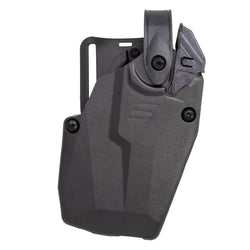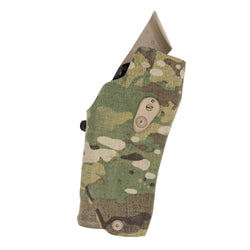In 2025, the U.S. Army celebrates its 250th birthday. Dogs have accompanied soldiers into battle since the beginning. Of those 250 years, Military Working Dogs (MWDs) have officially served for 83. On March 13, 1942, during World War II, the U.S. Army launched its War Dog Program.
These four-legged teammates have repeatedly proven themselves to be the greatest combat multiplier on the battlefield. I can tell you from personal experience—I’m alive today, on more than one occasion, because of the incredible actions of these K9s.
We are working on a first-of-its-kind military working dog documentary, covering K9s from World War I through the Global War on Terror. The War Dog’s Story – Giving a Voice to the Voiceless. Watch the trailer below to learn more about these incredible teammates.
The beginning
During the Revolutionary War, dogs were a common sight on the battlefield, though not in the capacity we think of today. These pets traveled with their handlers, both American and British alike. Some notable handlers included George Washington, Baron Von Steuben, and Continental Army General Charles Lee. There are numerous portraits from that time period depicting soldiers and their K9 companions.
The Civil War
During the Civil War, there were numerous animals that were used by both the North and South in a variety of roles on the battlefield. The majority of the dogs were mascots, traveling with their units as they moved from location to location, including the battlefield, where they would comfort the wounded.
The Civil War marked the first use of the term “War Dog.” Author John D. Lippy Jr. wrote a book about a dog named Sallie, who served with the 11th Pennsylvania Infantry Regiment, titled The War Dog.
The Great War
In World War I, animals were used on a scale never seen before—and never duplicated again. More than 16,000 animals served with the US Army, the majority being horses, donkeys, and mules used to haul supplies to the men in the trenches. Pigeons and dogs were used to carry messages between the trenches.
Although the United States military did not have a Military Working Dog program in place during WWI, there were plenty of military mascot dogs in the trenches with the American troops. These dogs served no tactical purpose but were a morale booster for the men and brought a sort of normalcy to a very deadly situation.
world war ii
When the Japanese attacked Pearl Harbor on December 7, 1941, the US Army only used K9s as sled dogs in arctic regions. That changed with the help of Dogs for Defense and the American Kennel Club, who worked to provide dogs for a formal Military Working Dog program. On March 13, 1942, the U.S. Army officially launched its War Dog Program under the Quartermaster Corps.
The first dogs were trained for domestic sentry duty, prompted by German and Japanese submarine activity off both coasts. There were real concerns about saboteurs potentially landing and accessing military or war industry facilities. Within a year, more than 1,800 military working dog teams were patrolling U.S. coastlines. By the end of the war, 3,174 dogs had been assigned to the Coast Guard for sentry duties.

Military Working Dogs were sent to both the Pacific and European theaters and saved a lot of US service members’ lives. Two notable K9s included K9 Chips, a German Shepherd, and K9 Cappy, a Doberman Pinscher.
During the invasion of Sicily, Chips made a beeline for a machine gun bunker. Within seconds, the machine gun fell silent, and an Italian soldier tumbled out with Chips attached to him.
In the battle of Guam alone, of the 60 dogs that landed on the island, 25 were Killed In Action. One standout War Dog was Cappy, a Doberman credited with saving the lives of 250 Marines. Using his keen sense of smell, he detected and alerted his Marines to the approach of Japanese soldiers.
Following the war, many dogs were returned to their owners or given to their wartime handlers.
korean conflict
When the Korean War came, the US Military had lost the robust K9 program of World War II and still relied on citizens to sell their pets—all German Shepherds usually anywhere from 2 to 6 years old and had established lives as civilian pets. These K9s went from pets to becoming US Government equipment.
The handlers and their K9s trained for several months at Fort Carson, Colorado, before shipping off to Korea. Their primary mission was to serve as sentry dogs, guarding ammunition depots and protecting these areas from attack or pilferage.
There is not a lot of information about the Military Working Dogs in Korea, but J. Rachel Reed researched and wrote about the subject in her book, K-9 Korea: The Untold Story of America’s War Dogs in the Korean War. Unfortunately, these dogs were looked at as equipment and just abandoned by the US Government.
Listen to K9 handlers John Burnam and Grant Hatch share stories from Vietnam and Korea.
Vietnam
U.S. Military Working Dogs were once again called into action to help save American lives in the steamy jungles of South Vietnam. The dogs were deployed as sentries, scouts, mine and booby-trap detectors, and tracking dogs, to find hidden enemy jungle locations.
These scout dogs were so much of a threat to the North Vietnamese that they put a price on the dogs’ heads. Collectively, these 4,000-plus Military Working Dogs carried out over 87,000 combat missions. Vietnam War dogs uncovered over 2,000 tunnels and bunkers, enabled 1,000 enemy captures, and contributed to more than 4,000 enemy kills.
Their heroics saved 10,000 American Service Members’ lives, which most handlers say is grossly underestimated. Approximately 270 dog handlers and 500 Military Working Dogs were killed in action during the Vietnam War.
Sadly, in 1975, when the US pulled out of Vietnam, the four-legged teammates who had saved so many lives were just abandoned because they were looked at as equipment, not as fellow service members.

Robby’s Law
In 2000, President Clinton signed Robby’s Law into effect (10 U.S.C. 2583), allowing Military Working Dogs to be adopted—first by their former handlers, then by law enforcement and government agencies, and finally by private citizens. Robby’s handler wanted to adopt him and made attempts to do so. Sadly, Robby was euthanized.
the global war on terror (gwot)
September 11, 2001, changed the world forever, and once again, US Military Working Dogs would make the difference on the battlefield between life and death. The US military was once again caught off guard and would have to build back its Military Working Dog program.
Due to the increasing threat of Improvised Explosive Devices (IEDs), the Army established the Specialized Search Dog (SSD) program. These dogs were trained specifically to detect deadly explosives before they could harm U.S. service members.

I was fortunate to be part of a unit that already had a dual-purpose Military Working Dog program—both apprehension and explosive detection—and I immediately saw the value of these incredible teammates. My life was saved numerous times because of our dogs. In my opinion they were the biggest combat multiplier on the battlefield.
For a list of SOF K9s killed in action, go to https://www.warhogg.com/sof-k9s-killed-in-action
The future of the US Army Military Working Dog Program
After 20 years of war during the GWOT, a lot of bloodshed, and lessons learned on the battlefield, it looks like the Army will repeat its mistakes of the past and shrink down its Military Working Dog program.
The problem is that it takes time to acquire these dogs and get them ready for combat. Their value has been proven time and time again on the battlefield and in lives saved.









